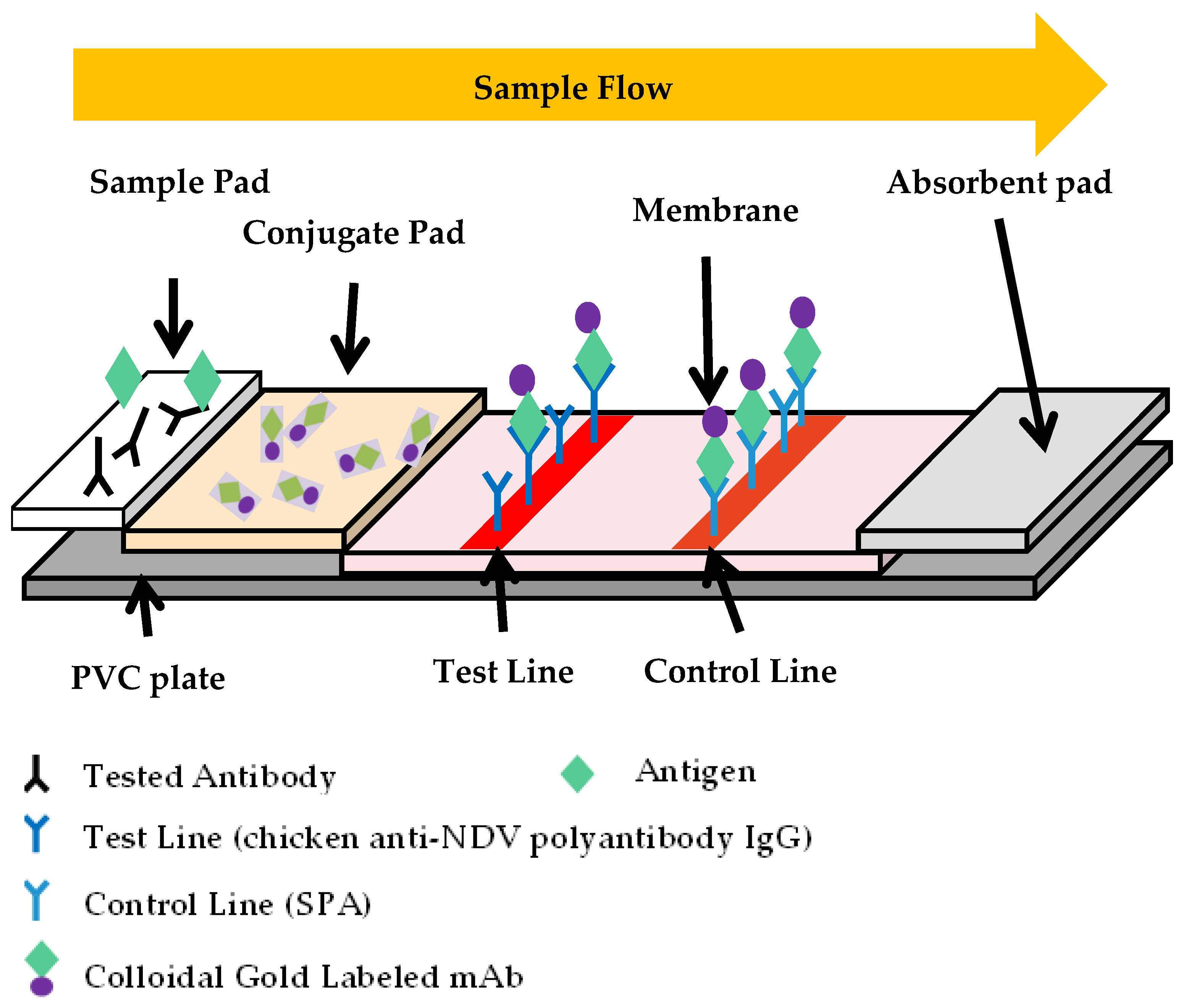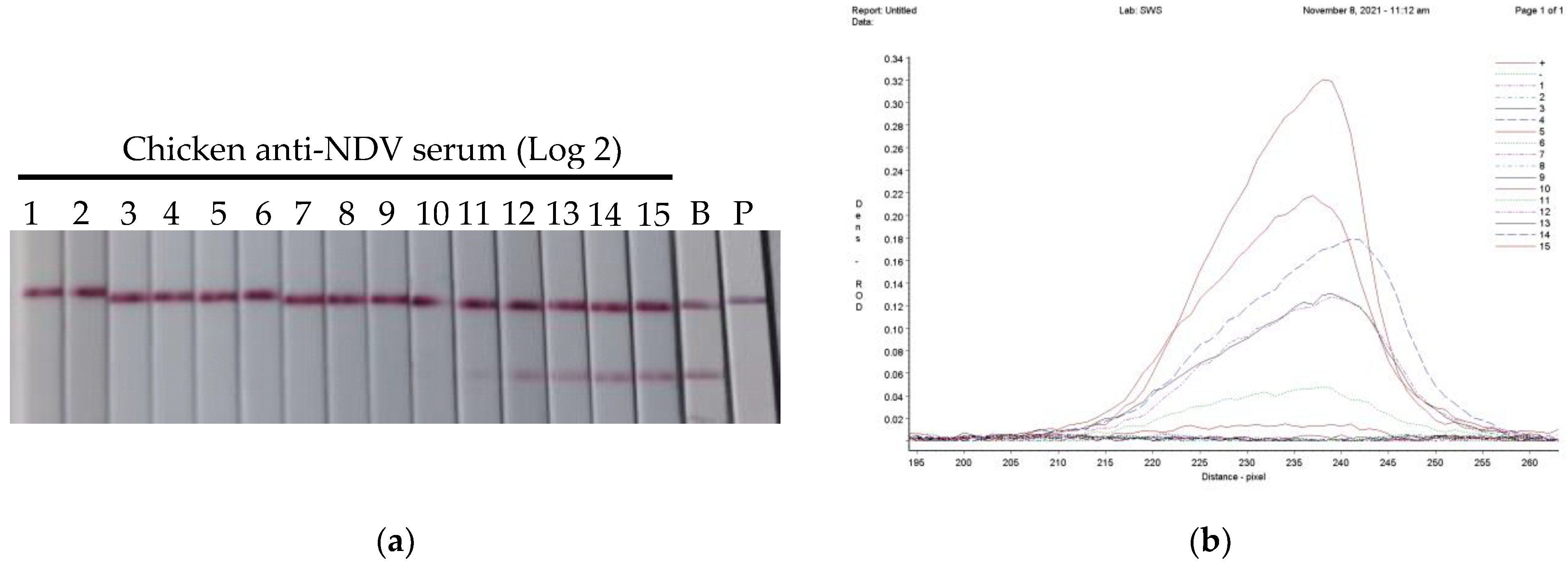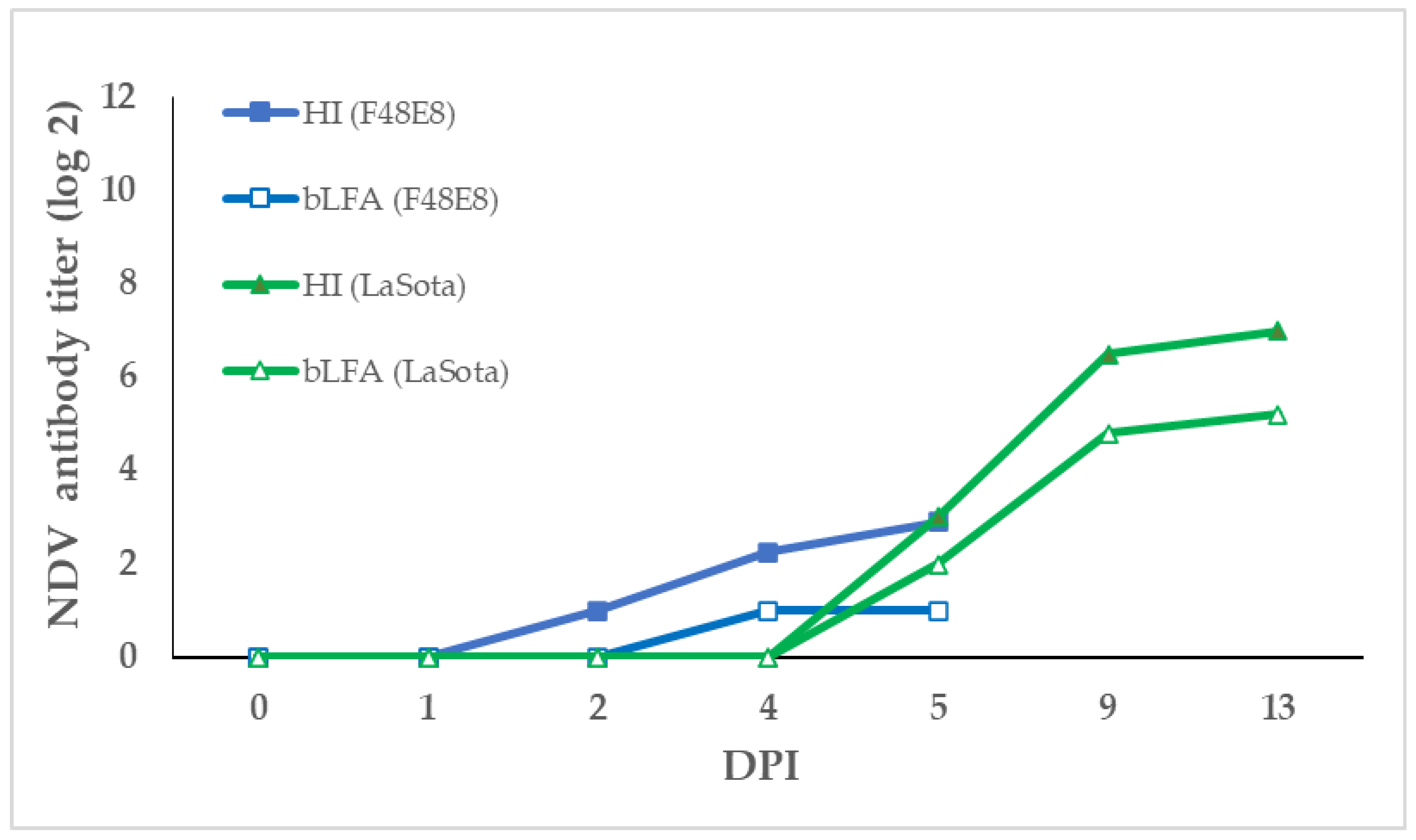Development and Evaluation of a Blocking Lateral Flow Assay Strip for Detection of Newcastle Disease Virus Antibodies
Abstract
Simple Summary
Abstract
1. Introduction
2. Materials and Methods
2.1. Viruses and Antibodies
2.2. Preparation of Antigen for Detection
2.3. Monoclonal Antibody Pairing Test and Principles of bLFA Strip
2.4. Optimization of Antibody Blocking Detection Method
2.5. Sensitivity of the bLFA Strip
2.6. Virus Neutralization Test
2.7. Specificity of the bLFA Strip
2.8. The Dynamic Change of Anti-NDV Antibody in Infected and Vaccinated Chickens
2.9. The bLFA Strip Stability
2.10. Clinical Application of Newcastle Disease Antibody bLFA Strip
3. Results
3.1. Establishment of the bLFA Strip
3.2. Procedures of bLFA Strip
3.3. Sensitivity of the bLFA Strip
3.4. Specificity of the bLFA Strip
3.5. The Dynamic Change of Anti-NDV Antibody in Infected and Vaccinated Chickens
3.6. The Storage Life
3.7. Detection of Newcastle Disease Antibody in Clinical Specimens
4. Discussion
Author Contributions
Funding
Institutional Review Board Statement
Informed Consent Statement
Data Availability Statement
Acknowledgments
Conflicts of Interest
References
- Rima, B.; Balkema-Buschmann, A.; Dundon, W.G. ICTV Virus Taxonomy Profile: Paramyxoviridae. J. Gen. Virol. 2019, 100, 1593–1594. [Google Scholar] [CrossRef]
- Kabir, H.; Hakim, H.; Alizada, M.N.; Hasan, A.; Miyaoka, Y.; Yamaguchi, M.; Shoham, D.; Takehara, K. Isolation, Identification, and Molecular Characterization of Newcastle Disease Virus from Field Outbreaks in Chickens in Afghanistan. Avian Dis. 2022, 66, 176–180. [Google Scholar] [CrossRef] [PubMed]
- Qu, Z. Epidemiological characteristics and prevention and control measures of Newcastle disease in chickens. Breed. Feed. 2022, 21, 104–106. [Google Scholar]
- Tian, L.; Li, L. Truncated expression of HN gene of Newcastle disease virus and establishment and application of indirect ELISA antibody detection method. China Poult. 2012, 34, 29–32. [Google Scholar]
- Kattenbelt, J.A.; Stevens, M.P.; Gould, A.R. Sequence variation in the Newcastle disease virus genome. Virus Res. 2006, 116, 168–184. [Google Scholar] [CrossRef]
- Dortmans, J.C.; Koch, G.; Rottier, P.J.; Peeters, B.P. Virulence of Newcastle disease virus: What is known so far? Vet. Res. 2011, 42, 122. [Google Scholar] [CrossRef]
- Zhao, N.; Grund, C.; Beer, M.; Harder, T.C. Engineered recombinant protein products of the avian paramyxovirus type-1 nucleocapsid and phosphoprotein genes for serological diagnosis. Virol. J. 2018, 15, 8. [Google Scholar] [CrossRef]
- Senne, D.A.; King, D.J.; Kapczynski, D.R. Control of Newcastle disease by vaccination. Dev. Boil. 2004, 119, 165–170. [Google Scholar]
- Wang, J.; Yu, X.; Zheng, D.; Zhao, Y.; Lv, Y.; Shu, B.; Jiang, W.; Liu, S.; Li, J.; Hou, G.; et al. Continuous surveillance revealing a wide distribution of class I Newcastle disease viruses in China from 2011 to 2020. PloS ONE 2022, 17, e0264936. [Google Scholar] [CrossRef]
- Huang, H. Diagnosis and prevention of Newcastle disease in chickens. Mod. Anim. Husb. Sci. Technol. 2022, 5, 103–104. [Google Scholar]
- Jia, L.; Liang, B.; Wu, K.; Wang, R.; Liu, H.; Liu, D.; Chen, Q. Circulation, genomic characteristics, and evolutionary dynamics of class I Newcastle disease virus in China. Virulence 2022, 13, 414–427. [Google Scholar] [CrossRef]
- Ganar, K.; Das, M.; Sinha, S.; Kumar, S. Newcastle disease virus: Current status and our understanding. Virus Res. 2014, 184, 71–81. [Google Scholar] [CrossRef] [PubMed]
- Dimitrov, K.M.; Afonso, C.L.; Yu, Q.; Miller, P.J. Miller, Newcastle disease vaccines—A solved problem or a continuous challenge? Vet. Microbiol. 2017, 206, 126–136. [Google Scholar] [CrossRef] [PubMed]
- Zhang, Z.; Guo, L.; Song, J. Epidemiological analysis and prevention and control of Newcastle disease in chickens. Anim. Husb. Vet. Sci. Technol. Inf. 2022, 2022, 156–158. [Google Scholar]
- Bruce, C.; Beate, C.; Sharon, H. Conventional and future diagnostics for avian influenza. (Special Issue: Avian influenza.) Comparative Immunology. Microbiol. Infect. Dis. 2009, 32, 341–350. [Google Scholar]
- Hauslaigner, R.; Sonnenburg, J.; Kothlow, S.; Kaspers, B.; Staubach, C.; Grund, C. Evaluation of an indirect enzyme-linked immunosorbent assay to study the specific humoral immune response of Muscovy ducks (Cairina Moschata) and domestic geese (Anser Anser Var. Domestica) after vaccination against Newcastle disease virus. Avian Pathol. J. WVPA 2009, 38, 89–95. [Google Scholar] [CrossRef] [PubMed]
- Mao, Q.; Ma, S.; Schrickel, P.L.; Zhao, P.; Wang, J.; Zhang, Y.; Li, S.; Wang, C. Review detection of Newcastle disease virus. Front. Vet. Sci. 2022, 9, 936251. [Google Scholar] [CrossRef] [PubMed]
- Zhao, Y.; Zhao, Y.; Wu, H. Epidemiological genotype analysis of poultry Newcastle disease virus in my country. Adv. Anim. Med. 2022, 43, 107–111. [Google Scholar]
- Du, J.; Xia, J.; Li, S.; Shen, Y.; Chen, W.; Luo, Y.; Zhao, Q.; Wen, Y.; Wu, R.; Yan, Q.; et al. Evolutionary dynamics and transmission patterns of Newcastle disease virus in China through Bayesian phylogeographical analysis. PLoS ONE 2020, 15, e0239809. [Google Scholar] [CrossRef]
- Absalón, A.E.; Cortés-Espinosa, D.V.; Lucio, E.; Miller, P.J.; Afonso, C.L. Epidemiology, control, and prevention of Newcastle disease in endemic regions: Latin America. Trop. Anim. Health Prod. 2019, 51, 1033–1048. [Google Scholar] [CrossRef]
- Dorozhkin, V.I.; Denisova, S.A.; Lavina, L.; Zakharova, L.; Popov, N.I. Lateral flow assays to evaluate bacterial and toxic contamination of animal raw materials. IOP Conf. Ser. Earth Environ. Sci. 2022, 1052, 012115. [Google Scholar] [CrossRef]
- Saxena, A.; Pal, V.; Tripathi, N.K.; Goel, A.K. Braz. J. Microbiol. 2022, 53, 185–193. [CrossRef] [PubMed]
- Zhang, D.; Cai, J.; Yuan, Q. Advances in Newcastle Disease Detection and Research Methods. Poult. Prev. Control. Poult. Dis. 2020, 2020, 20–22. [Google Scholar]
- Wang, Y.; Liu, X.; Li, Q. Research progress of immunochromatographic test strip detection technology. J. Henan Univ. Sci. Technol. 2017, 35, 224–236. [Google Scholar]
- Li, X. Preparation of Chicken Newcastle Disease Monoclonal Antibody and Development of Immunocolloidal Gold Diagnostic Test bLFA Strip. Ph.D. Thesis, Shandong Agricultural University, Jinan, China, 2006. [Google Scholar]
- Zhang, Z. Development and Preliminary Application of Colloidal Gold-Speed Test Strip for Chicken Newcastle Disease Antibody Immunity. Ph.D. Thesis, Huazhong Agricultural University, Wuhan, China, 2008. [Google Scholar]
- Li, Q.; Wang, L.; Sun, Y. Evaluation of an immunochromatographic strip for detection of avian avulavirus 1 (Newcastle disease virus). J. Vet. Diagn. Invest. 2019, 31, 475–480. [Google Scholar] [CrossRef] [PubMed]
- Page, M.; Thorpe, R. Purification of IgG by Precipitation with Sodium Sulfate or Ammonium Sulfate. In The Protein Protocols Handbook, 2nd ed.; Walker, J.M., Ed.; Humana Press: Totowa, NJ, USA, 2002; pp. 983–985. [Google Scholar]
- Zhang, S.; Xu, Q.; Yang, J.; Li, Q.; Sun, Y.; Li, X.; Wang, Y.; Niu, X.; Qu, X.; Chen, J.; et al. Expression of NDV HN protein in rice and development of a semi-quantitative rapid method for detection of antibodies. Chin. J. Biol. Eng. 2022, 38, 1981–1993. [Google Scholar]
- World Organization for Animal Health (OIE). Newcastle Disease. In Manual of Diagnostic Tests and Vaccines for Terrestrial Animals: Mammals, Birds and Bees. Biological Standards Commission; OIE: Paris, France, 2012; pp. 555–574. [Google Scholar]
- Zhao, H.; Wen, Q.; Wu, Y. Epidemiological trend of virulent infection of Newcastle disease in immunized chickens. Chin. Vet. J. 2002, 2022, 10–12. [Google Scholar]




| mAbs | mAb Affinity for the Virus (LaSota) (Log 2) 1 | bLFA for NDV Serum (Log 2) 2 |
|---|---|---|
| 1B3 | 0 | /3 |
| 2A5 | 0 | / |
| 2C1 | 4 | 9 |
| 3G5 | 7 | 10 |
| 4D2 | 5 | 11 |
| 5D6 | 5 | 9 |
| 5E10 | 0 | / |
| 5F2 | 4 | 11 |
| 9C1 | 7 | 12 |
| 16G2 | 0 | / |
| Solution Concentration | Optimized Conditions | |
|---|---|---|
| mAb conjugation | Ascitic fluid | 50 µg/mL |
| Gold conjugate | 10-time concentrated | 5 µL/cm |
| Chicken anti-NDV polyantibody IgG (T-line) | 1 mg/mL | 5 µL/cm |
| SPA (C-line) | 0.3 mg/mL | 5 µL/cm |
| HN protein (dilution) | 0.14 ng/µL | 100 µL/well |
| Sample Dilution (Log 2) | bLFA Strip Test | HI Test | VN Test | |
|---|---|---|---|---|
| ROD | Result | |||
| 1 | 5.0558 | + | + | + |
| 2 | 5.5298 | + | + | + |
| 3 | 4.7175 | + | + | + |
| 4 | 5.4086 | + | + | + |
| 5 | 5.9615 | + | + | + |
| 6 | 4.2498 | + | + | + |
| 7 | 4.0453 | + | + | + |
| 8 | 4.6972 | + | + | + |
| 9 | 5.198 | + | + | + |
| 10 | 19.449 | + | + | + |
| 11 | 53.8691 | + | + | + |
| 12 | 133.7207 | − | + | + |
| 13 | 139.0825 | − | + | + |
| 14 | 189.8185 | − | − | + |
| 15 | 216.4233 | − | − | − |
| Blank | 278.3367 | − | − | − |
| PBS | 5.5128 | − | − | − |
| Storage Time (mo) | Sensitivity | Specificity | |
|---|---|---|---|
| Hyperimmunized Serum (HI 13 log 2) | AI H7 Positive Serum | Negative Serum | |
| 0 | 11 log 2 | −1 | − |
| 3 | 11 log 2 | − | − |
| 6 | 11 log 2 | − | − |
| 9 | 11 log 2 | − | − |
| 12 | 11 log 2 | − | − |
| 18 | 10 log 2 | − | − |
| bLFA Strip | HI Test | Total | |
|---|---|---|---|
| Positive | Negative | ||
| Positive | 485 (TP) | 0 (FP) | 485 |
| Negative | 20 (FN) | 13 (TN) | 33 |
| Total | 505 | 13 | 510 |
Disclaimer/Publisher’s Note: The statements, opinions and data contained in all publications are solely those of the individual author(s) and contributor(s) and not of MDPI and/or the editor(s). MDPI and/or the editor(s) disclaim responsibility for any injury to people or property resulting from any ideas, methods, instructions or products referred to in the content. |
© 2023 by the authors. Licensee MDPI, Basel, Switzerland. This article is an open access article distributed under the terms and conditions of the Creative Commons Attribution (CC BY) license (https://creativecommons.org/licenses/by/4.0/).
Share and Cite
Lv, R.; Guo, J.; Zhang, Y.; Wang, X.; Li, G.; Meng, Z.; Wang, L.; Chai, S.; Li, Q.; Zhang, G. Development and Evaluation of a Blocking Lateral Flow Assay Strip for Detection of Newcastle Disease Virus Antibodies. Vet. Sci. 2023, 10, 152. https://doi.org/10.3390/vetsci10020152
Lv R, Guo J, Zhang Y, Wang X, Li G, Meng Z, Wang L, Chai S, Li Q, Zhang G. Development and Evaluation of a Blocking Lateral Flow Assay Strip for Detection of Newcastle Disease Virus Antibodies. Veterinary Sciences. 2023; 10(2):152. https://doi.org/10.3390/vetsci10020152
Chicago/Turabian StyleLv, Rongzhou, Junqing Guo, Yuhang Zhang, Xun Wang, Ge Li, Zekun Meng, Li Wang, Shujun Chai, Qingmei Li, and Gaiping Zhang. 2023. "Development and Evaluation of a Blocking Lateral Flow Assay Strip for Detection of Newcastle Disease Virus Antibodies" Veterinary Sciences 10, no. 2: 152. https://doi.org/10.3390/vetsci10020152
APA StyleLv, R., Guo, J., Zhang, Y., Wang, X., Li, G., Meng, Z., Wang, L., Chai, S., Li, Q., & Zhang, G. (2023). Development and Evaluation of a Blocking Lateral Flow Assay Strip for Detection of Newcastle Disease Virus Antibodies. Veterinary Sciences, 10(2), 152. https://doi.org/10.3390/vetsci10020152





